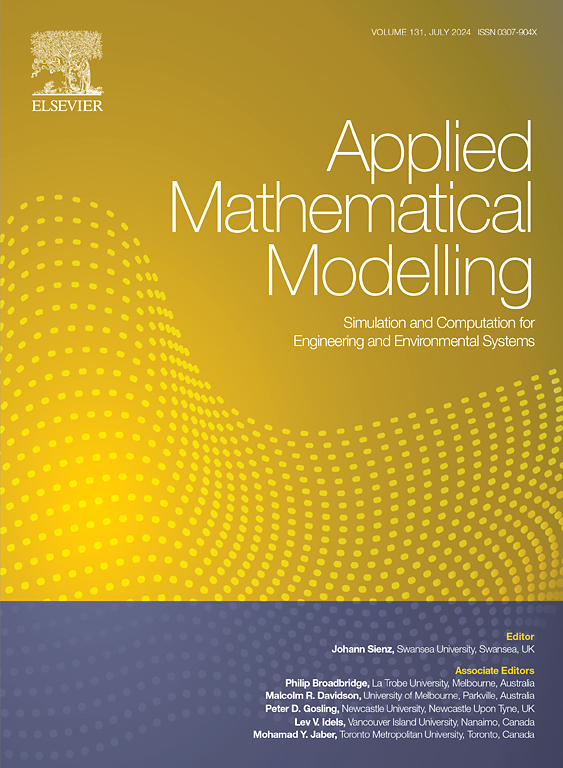用于食品安全的细菌动态空间特征:共享水处理环境建模
IF 4.4
2区 工程技术
Q1 ENGINEERING, MULTIDISCIPLINARY
引用次数: 0
摘要
在食品加工过程中,共用水环境中发生的细菌动态变化通常是以均匀混合曲线为假设进行建模的。然而,考虑到水箱配置以及许多设施中使用的水循环和回用规格,均匀混合并不总是适用的。为此,我们开发了一种新型反应-扩散-对流模型,以捕捉动态条件下水箱中的时空变化。我们以家禽冷冻过程中的动态变化为例,因为这一过程是细菌、水化学和水流动态综合相互作用的结果,同时也决定了进入食品生产链最后阶段的胴体上的细菌水平,从而直接影响公共卫生风险。研究证明了具有全局稳定性的正稳态解的良好假设性、存在性和唯一性,并对收敛到稳态解的时间尺度进行了估计。我们利用模拟来验证分析结果,并根据一般非致病性大肠杆菌的实验数据提供参数,预测达到平衡的时间。我们发现,在一个典型的 8 小时加工班次中,该模型可在 2 小时内达到稳态,并将这一结果用于根据商业数据验证模型模拟。校准后的模型预测冷却后胴体上的大肠杆菌水平分布的平均值和标准偏差为 3.35 ± 0.56 Log10 CFU/胴体,这与在工业环境中实验观察到的 3.55 ± 0.64 Log10 CFU/胴体的分布非常接近。我们的研究结果强化了空间在量化家禽冷藏过程中水化学和大肠杆菌动态基本机制方面的关键作用。我们的模型是改善家禽冷藏过程中病原体控制决策的重要工具,也是建立新鲜农产品和猪肉等其他商品加工模型的蓝本。本文章由计算机程序翻译,如有差异,请以英文原文为准。
Spatial characterizations of bacterial dynamics for food safety: Modeling for shared water processing environments
Bacterial dynamics occurring in shared water environments during food processing are typically modeled assuming a homogeneous mixing profile. However, given the tank configurations, and water recirculation and reuse specifications used in many facilities, uniform mixing is not always applicable. Towards this goal, we here developed a novel reaction-diffusion-advection model that captures temporal and spatial variations in the water tanks under dynamic conditions. We utilize the dynamics involved in poultry chilling as an example, as this process features a comprehensive interplay of bacteria, water chemistry and water flow dynamics, as well as determining bacteria levels on carcasses moving into final phases of the food production chain, thus directly influencing public health risk. Well-posedness, existence and uniqueness of positive steady-state solutions with global stability are proved, as well as an estimation of the time scale of convergence to the steady-state solution provided. Simulations are used to verify the analytical results incorporating parameters informed by experimental data from generic, non-pathogenic E. coli, and predictively estimate the time to equilibrium. We show that during a typical 8 h processing shift, the model reaches steady state within 2 h, applying this result to validate model simulations against commercial data. The calibrated model predicts a distribution of E. coli levels on post-chill carcasses with mean and standard deviation of 3.35 ± 0.56 Log10 CFU/carcass, which closely compares to the experimentally observed distribution of 3.55 ± 0.64 Log10 CFU/carcass in an industrial setting. Our results reinforce the key role of space in quantifying essential mechanisms that govern water chemistry and E. coli dynamics during poultry chilling. Our model is an important tool to improve decision making for pathogen control during poultry chilling, as well as a blueprint from which models for processing other commodities like fresh produce and pork can be established.
求助全文
通过发布文献求助,成功后即可免费获取论文全文。
去求助
来源期刊

Applied Mathematical Modelling
数学-工程:综合
CiteScore
9.80
自引率
8.00%
发文量
508
审稿时长
43 days
期刊介绍:
Applied Mathematical Modelling focuses on research related to the mathematical modelling of engineering and environmental processes, manufacturing, and industrial systems. A significant emerging area of research activity involves multiphysics processes, and contributions in this area are particularly encouraged.
This influential publication covers a wide spectrum of subjects including heat transfer, fluid mechanics, CFD, and transport phenomena; solid mechanics and mechanics of metals; electromagnets and MHD; reliability modelling and system optimization; finite volume, finite element, and boundary element procedures; modelling of inventory, industrial, manufacturing and logistics systems for viable decision making; civil engineering systems and structures; mineral and energy resources; relevant software engineering issues associated with CAD and CAE; and materials and metallurgical engineering.
Applied Mathematical Modelling is primarily interested in papers developing increased insights into real-world problems through novel mathematical modelling, novel applications or a combination of these. Papers employing existing numerical techniques must demonstrate sufficient novelty in the solution of practical problems. Papers on fuzzy logic in decision-making or purely financial mathematics are normally not considered. Research on fractional differential equations, bifurcation, and numerical methods needs to include practical examples. Population dynamics must solve realistic scenarios. Papers in the area of logistics and business modelling should demonstrate meaningful managerial insight. Submissions with no real-world application will not be considered.
 求助内容:
求助内容: 应助结果提醒方式:
应助结果提醒方式:


